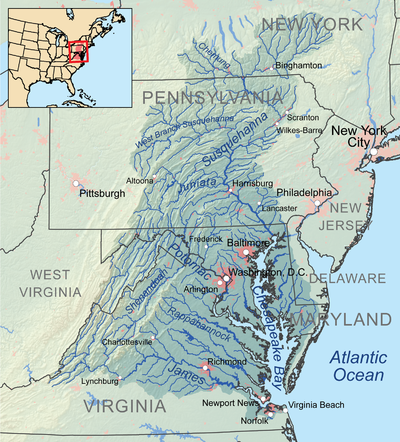Multi-State Approaches to Environmental Restoration in the Chesapeake Bay and Water Diplomacy Framework Opportunities
| Geolocation: | 38° 34' 24.1142", -76° 22' 13.3017" |
|---|---|
| Total Population | 1717,000,000 millionmillion |
| Total Area | 165759.24165,759.24 km² 63,999.643 mi² km2 |
| Climate Descriptors | Humid mid-latitude (Köppen C-type), Continental (Köppen D-type) |
| Predominent Land Use Descriptors | agricultural- cropland and pasture, agricultural- confined livestock operations, urban, urban- high density |
| Important Uses of Water | Domestic/Urban Supply, Fisheries - wild, Livestock, Other Ecological Services, Recreation or Tourism |
| Water Features: | Chesapeake Bay, Atlantic Ocean, Susquehanna River, Potomac River, James River |
| Riparians: | The United States of America |
Contents
Summary
Natural, Historic, Economic, Regional, and Political Framework
The Conflict
The conflict has been over how to best restore the bay’s environmental conditions. Some have favored voluntary approaches, with others calling for stricter regulatory approaches. Given states’ reluctance towards additional regulation, especially with economic interests that favor minimal regulation, voluntary approaches have been the main approach to targeted bay restoration. The conflict resolution mechanism for those efforts has been multi-state agreements, coordinated by the Chesapeake Bay Program and EPA. Through those documents, states have agreed to joint restoration goals, with varying levels of specificity, but little or no particular commitment or accountability (Cannon, 2006). After several failed agreements and new versions of agreements, the states and EPA finally acknowledged the need for a TMDL, a regulatory approach for bay restoration with specific commitments, accountability, and backstops.
Geographic Background
The Chesapeake Bay is a tidal estuary, with a watershed area of 64,000 square miles in the states of Virginia, Maryland, Delaware, West Virginia, Pennsylvania, and New York, as well as Washington D.C. The bay’s coastline stretches 11,864 miles, with 50 major tributaries including the Susquehanna, Potomac, Rappahannock, York, and James Rivers. The bay’s watershed has a land to water ratio of 14:1, the largest such ratio of any coastal waterbody in the world. As a result, land use greatly influences the quality of the bay’s waters (CBP, 2017).
Over 17 million people live in the watershed (CBF, 2017), with a diversity of jurisdictions and land uses. In particular, the watershed includes 1,650 local governments, four large metropolitan areas in Baltimore, Maryland, Norfolk and Richmond, Virginia, and Washington, D.C (Ernst, 2003, 39-40). In addition, the watershed includes rural areas and productive agricultural areas, such as Lancaster County in Pennsylvania and the Delmarva Peninsula (Brull, 2006, 2), which includes most of Delaware and the Eastern Shores of Maryland and Virginia.
The bay is home to over 3,600 species of plants and animals, including 348 finfish species and 173 shellfish species (CBF, 2017). The blue crab is perhaps the most famous and critical of these species. In fact, the name Chesapeake Bay comes from the Algonquin description “great shellfish bay.” The bay’s fish population was once so great that early English settlers were said to have tried to catch them with a frying pan. Famous Baltimore report H.L. Mencken once referred to the Chesapeake as “the immense protein factory” (Brull, 2006, 3). Today, the bay continues to support a fishing industry worth $1 billion (Ernst, 2003, 11).
Issues and Stakeholders
The bay’s environmental quality, especially water quality, is degraded. How should those conditions be restored?
NSPD: Water Quality, Ecosystems, Governance
Stakeholder Types: Federated state/territorial/provincial government, Sovereign state/national/federal government, Local Government, Non-legislative governmental agency, Environmental interest, Industry/Corporate Interest, Community or organized citizens
There are competing interests among and within jurisdictions. Voluntary, interstate agreements have been the primary approach, with minimal results. Eventually, those agreements led to a total maximum daily load (TMDL).
Stakeholders
- States (Virginia, Maryland, Delaware, West Virginia, Pennsylvania, New York)
- Washington, D.C.
- Federal Government (United States Environmental Protection Agency (US EPA))
- Chesapeake Bay Commission
- Chesapeake Bay Foundation
- Interest Groups
Analysis, Synthesis, and Insight
Individuals may add their own Analysis, Synthesis, and Insight (ASI) to a case. ASI sub-articles are protected, so that each contributor retains authorship and control of their own content. Edit the case to add your own ASI.
Learn moreNo ASI articles have been added yet for this case
Key Questions
Transboundary Water Issues: What kinds of water treaties or agreements between countries can provide sufficient structure and stability to ensure enforceability but also be flexible and adaptable given future uncertainties?
no description entered




